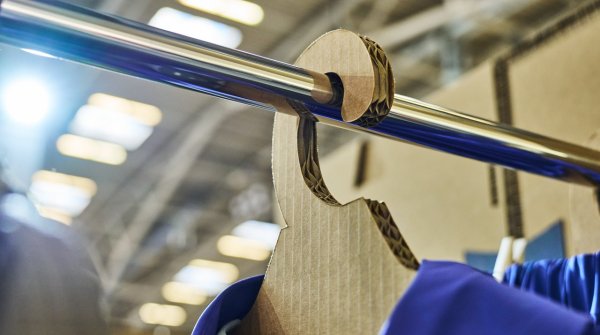- What is the Microfibre Consortium?
- What is behind the Microfibre Consortium's 2030 Initiative?
- What is the Microfibre Roadmap?
- What method does the Microfibre Consortium use?
- Who can contribute to the TMC?
- What motivates the outdoor brands?
- What are the biggest challenges in production?
- Positive examples from the industry
Sophie Mather is a textile engineer by training and works with several textile research groups in the biosynthetic field. She describes herself as a "materials futurist who brings strategy, vision and deep technical expertise to sustainable challenges and opportunities." Previously, she worked in the sports industry and spent time in Southeast Asia. We interviewed her to learn how the Microfibre Consortium is sparking a movement across the industry to reduce microfibers.
The Microfibre Consortium is the only global organization 100% dedicated to fiber fragmentation. We are a research-led, sustainable textile NGO based on the insights of Katy Stevens and the European Outdoor Group. In September 2021, the Microfibre 2030 Commitment was defined as a common goal shared by a community of signatories. The first two steps were to set specific goals with a 2030 Commitment and a Roadmap for Microfibers.
We are currently 82 signatories, all taking responsibility for solving the problem and contributing to sustainable collaboration, proactively and across industries.
This formal commitment provides a clear direction of travel to deepen knowledge across the sector and implement practical actions. All signatories agree that as a global collective, we want to work toward reducing the environmental impact of textile fiber fragmentation to zero by 2030. We are an organization that relies heavily on science and make data analysis a priority.
With this commitment, organizations have chosen to put fiber fragmentation at the top of their agenda. By putting themselves in a position to influence progress, they are becoming industry leaders in introducing innovative solutions. As part of their public commitment, brands, retailers and research institutes are required to submit material test results each year and upload findings and technical specifications to the Microfibre Data Portal. It is a common place for the industry to build knowledge and conduct root cause research. In addition to testing, signatories contribute in a number of targeted ways, particularly through participation in topic-specific working groups.
The Microfibre Roadmap sets the pace for delivering on the commitment. It describes the way forward and the specific steps to fulfill our commitment, and sets clear milestones for three pillars: Aligning the Sector, Understanding Fiber Fragmentation, and Preventing Fiber Fragmentation. These pillars are interconnected. The agenda is ambitious (as it must be) and can only be met through a combination of coordinated collective action and secure funding.
The Microfibre Roadmap will continue to evolve as knowledge grows and we are able to integrate further evidence on abatement measures. The Microfibre Consortium (TMC) Roadmap is in the activation phase, laying the groundwork for primary research, tools, and resources to be implemented beginning in 2024. Updating the TMC Roadmap is critical to ensure clarity, transparency and accountability through 2030.
The TMC test method is a standardized approach for determining fiber release. Based on the already established ISO 105-C06, the method has been developed so that it can be performed with standard laboratory equipment and provide accurate, comparable data. These can be commercially scaled in a range of laboratory facilities. Similarity to comparable methods is monitored, with closest proximity to AATCC (USA) and CEN/ISO (EU) methods. With the introduction of an accessible and adapted test method, the laboratory network that can support the provision of test data is growing. As of June 2022, 11 service providers with a total of 35 laboratories were accredited to use the TMC test method, allowing signatories to be supported worldwide.
Everyone from the industry and beyond can contribute: direct representatives of the apparel and textile industry, complementary industries and ambassadors such as researchers and academics, brands and retailers, apparel industry collaborations, laboratories, multi-stakeholder initiatives or policy makers. For us, this is critical to create a centralized action across the fashion and textile industry. TMC supports actions that can be taken across the value chain based on a clear, measurable agenda: The Microfibre 2030 Commitment and Roadmap.
For example, the Microfibre Data Portal has a wide range of real fabrics from the apparel industry. While a chenille sweater might be important to one of our signatories, a fine wool fabric might be important to another - neither would consciously search for data on the other fabric, but the value to us is in this aggregated data, which provides a unique perspective on the topic.
The Microfibre Consortium's 2021/2022 Progress Report describes the motivations of several brands:
- Patagonia™: We are proud to support the Microfibre 2030 Commitment because it is a driving force on the topic of fiber fragmentation, providing expert knowledge to the industry and bringing brands, retailers and manufacturers together in a science-led collaboration.
- Arcteryx™: We want to test even more by getting accredited internally in our lab. This will allow us to perform the Microfibre Consortium testing methodology and increase the number of tests performed per year. We have just ordered all the lab equipment we need and are about to start the accreditation process. For educational purposes, we regularly discuss the work of the Microfibre Consortium internally. Designers are aware of the initiative and take it into account when making decisions about materials and their impact on fragmentation in their products. We want to be proactive and take action internally, even though the research is ongoing and there are still many unknown factors that need to be assessed.
- Bergans™: Through the Microfibre Consortium, we have access to the latest insights in microfibre research and contribute to the industry's joint initiative to drive research and knowledge building.
- REI™: We need to know which yarn types contribute most to fiber fragmentation. The ability to compare materials is very valuable. We need a tool that designers can easily use to make informed decisions in product development.
The biggest global barriers are the lack of tools, awareness and knowledge. Thanks to all the signatories and collaborations at TMC, we are working to address these challenges. In my opinion, there are two critical phases we need to work in. Phase one was about identifying and capturing the diversity of technology use across the industry. Phase two, which is where we are now, is about capturing and establishing baselines so that progress can be measured, reported and managed effectively and transparently.
Thanks to our important partnership with ZDHC™, a dedicated working team of ZDHC and Microfibre Consortium members will focus on three key areas:
- Defining a test method that is globally available and can measure fiber loss in wastewater at the manufacturing level.
- Establishing a baseline for microfiber loss from manufacturing facilities.
- Aligning with a harmonized data infrastructure and developing a reporting structure that captures the measurement and control of microfibers from manufacturing facilities.
It is still too early to talk about impact. Currently, the Microfibre Roadmap is in the activation phase, building the infrastructure that will enable implementation starting in 2024. For a scientific response that truly gets to the root of the problem, there needs to be extensive investment in research that will allow us to reach a confident position in line with TMC's "no regret" approach. Once the root causes are identified, we can conduct targeted analyses on each driver of fiber fragmentation to create a deep understanding of the causes and recommend strategies for prevention.
Because we are science-driven, we need to be able to rely on the data and analysis we provide, and quality is more important than speed. To stay on track, an additional researcher has been added to our technical team, and we are strengthening our relationships with academia to ensure the robustness of the approaches and methods we develop.
"During the 2022 development cycle, Patagonia™ worked closely with manufacturer Tessile Fiorentina™ to reduce fiber fragmentation in a fleece fabric made from 42% recycled wool, 52% recycled polyester, 3% recycled polyamide and 3% other fibers. Initially, the microfiber emission was above Patagonia's internal limit for knitted fabrics. Thirteen tests were conducted to reduce fragmentation, using the Microfiber Consortium test method to quantify microfiber emission.
Fjällräven™ integrates fiber fragmentation testing into product development and applies the Microfibre Consotrium test method to all new synthetic materials. The brand also evaluates existing materials in its portfolio to ensure their quality in terms of microfiber avoidance. One type of material that the brand paid particular attention to was a fleece used in new products such as the Vardag Lite Fleece. The material is made from a new generation of recycled synthetic fibers that are dyed using a CO₂ dyeing process. Fjällräven wanted to select the best material, and for the first time, microfiber was also used as a selection criterion."
For "The Microfibre Consortium", the aim is to raise awareness in the industry, implement the roadmap, expand the network and thus further improve research. In 2024, the TMC will implement the second phase of the roadmap. The entire industry is invited to participate in the TMC by joining the initiative or providing data to the TMC as a signatory.
If you want to go fast, go alone, if you want to go far, go together - that's the motto of TMC. And the outdoor industry seems ready to go far. With a scientifically motivated goal, TMC is helping to get to the root of the problem.
- ISPO awards
- Mountain sports
- Bike
- Design
- Retail
- Fitness
- Health
- ISPO Job Market
- ISPO Munich
- ISPO Shanghai
- Running
- Brands
- Sustainability
- Olympia
- OutDoor
- Promotion
- Sports Business
- ISPO Textrends
- Triathlon
- Water sports
- Winter sports
- eSports
- SportsTech
- OutDoor by ISPO
- Heroes
- Transformation
- Sport Fashion
- Urban Culture
- Challenges of a CEO
- Trade fairs
- Sports
- Find the Balance
- Product reviews
- Newsletter Exclusive Area
- Magazine







